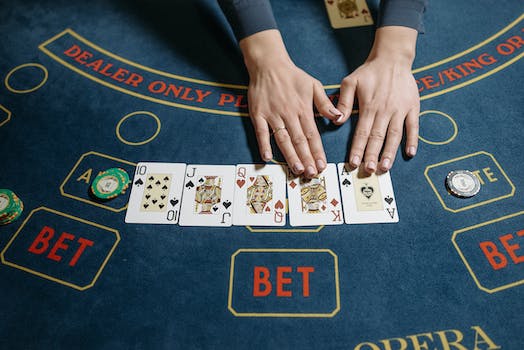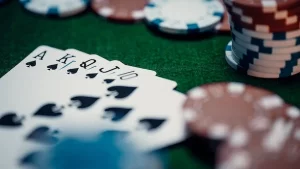Slow Play Secrets: Advanced Strategies for Trapping and Extracting Value is an article that delves into the art of slow playing in poker. The book provides advanced strategies for players to trap their opponents and extract maximum value from their hands. It covers various aspects of slow playing, including when to use it, how to execute it, and how to avoid common mistakes. The book is a valuable resource for poker players looking to take their game to the next level.
Maximizing Profits: Advanced Strategies for Slow Play in Poker
The first step in slow play is to identify the right situation. Slow play works best when you have a strong hand and your opponents have weaker hands. You should also consider the position of your opponents and the size of the pot. If the pot is small, slow play may not be the best strategy, as you may not be able to extract enough value from your hand.
Once you have identified the right situation, the next step is to set the trap. This involves playing your hand in a way that makes your opponents believe that they have a chance of winning. For example, if you have a strong hand like a set or a flush, you may want to check or call instead of raising. This will give your opponents the impression that they have a chance of winning, and they may be more likely to bet or raise.
The key to successful slow play is to be patient. You need to wait for the right moment to strike. This may mean waiting for your opponents to make a mistake or waiting for the pot to grow larger. You should also be prepared to change your strategy if the situation changes. For example, if a new player joins the table and starts playing aggressively, you may need to adjust your strategy to avoid being trapped.
Another important aspect of slow play is to control the pot. You should try to keep the pot small when you have a weak hand and large when you have a strong hand. This will help you extract maximum value from your hand and minimize your losses when you have a weak hand.
One of the most effective ways to control the pot is to use the check-raise. This involves checking when you have a strong hand and then raising when your opponents bet. This will not only help you control the pot, but it will also give your opponents the impression that you have a weaker hand than you actually do.
Finally, it is important to be aware of your opponents’ tendencies. If you know that a particular player is aggressive, you may want to slow play your hand to trap them into making a mistake. On the other hand, if you know that a player is tight, you may want to play more aggressively to force them to fold.
In conclusion, slow play is a powerful strategy that can help you maximize your profits at the poker table. To be successful, you need to identify the right situation, set the trap, be patient, control the pot, and be aware of your opponents’ tendencies. By mastering these advanced strategies, you can become a formidable opponent and extract maximum value from your hands.
The Art of Patience: How Slow Play Can Help You Win Big
Slow play is a deceptive strategy that involves playing a strong hand passively, allowing your opponents to catch up and potentially make a mistake. The goal is to extract maximum value from your hand by inducing your opponents to bet more than they should. However, slow play is not a one-size-fits-all strategy. It requires careful consideration of the board texture, your opponents’ tendencies, and your position at the table.
One of the most important factors to consider when slow playing is the board texture. If the board is dry and uncoordinated, slow playing may not be the best option. In this case, you should consider betting to build the pot and protect your hand. However, if the board is wet and coordinated, slow playing can be a powerful tool. By checking and allowing your opponents to catch up, you can induce them to bet more than they should, increasing the size of the pot.
Another important factor to consider when slow playing is your opponents’ tendencies. If your opponents are aggressive and likely to bet with weaker hands, slow playing can be a great way to trap them. By checking and allowing them to bet, you can induce them to commit more chips to the pot, increasing your potential payout. However, if your opponents are passive and unlikely to bet without a strong hand, slow playing may not be the best option. In this case, you should consider betting to build the pot and extract value.
Your position at the table is also an important factor to consider when slow playing. If you are in early position, slow playing can be risky. By checking and allowing your opponents to catch up, you risk giving them a free card that could improve their hand. However, if you are in late position, slow playing can be a powerful tool. By checking and allowing your opponents to bet, you can induce them to commit more chips to the pot, increasing your potential payout.
One advanced strategy for slow playing is the check-raise. This involves checking your strong hand and allowing your opponent to bet, then raising their bet to extract maximum value. The check-raise can be a powerful tool when used correctly, but it requires careful consideration of your opponents’ tendencies and the board texture.
Another advanced strategy for slow playing is the float. This involves calling your opponent’s bet with a weak hand, then betting on a later street when they check. The float can be a powerful tool when used correctly, but it requires careful consideration of your opponents’ tendencies and the board texture.
In conclusion, slow play is a powerful strategy that can help you extract maximum value from your strong hands while minimizing your losses when you have weaker holdings. However, it requires careful consideration of the board texture, your opponents’ tendencies, and your position at the table. By mastering the advanced strategies of slow play, you can become a more successful and profitable poker player.
Mastering the Mind Game: Advanced Slow Play Techniques
Slow Play Secrets: Advanced Strategies for Trapping and Extracting Value
The first step in mastering slow play is to understand the psychology behind it. When you slow play a hand, you are essentially pretending to have a weaker hand than you actually do. This can cause your opponents to become overconfident and make mistakes. However, slow playing too often can also be a mistake, as it can lead to missed opportunities for value.
One advanced slow play strategy is the check-raise. This technique involves checking your hand with the intention of raising your opponent’s bet on the next round of betting. The check-raise can be a powerful tool when used correctly, as it can induce your opponent to bet more aggressively, allowing you to extract more value from your strong hand.
Another advanced slow play strategy is the float. This technique involves calling your opponent’s bet with the intention of bluffing on a later street. The float can be a risky play, as it requires a good read on your opponent’s hand and betting patterns. However, when executed correctly, the float can be a highly effective way to extract value from a strong hand.
One key to successful slow play is to be aware of your opponents’ tendencies. If you are playing against a tight player who only bets with strong hands, slow playing may not be the best strategy. On the other hand, if you are playing against a loose player who bets with a wide range of hands, slow playing can be a highly effective way to trap them into making mistakes.
Another important factor to consider when using slow play is the texture of the board. If the board is highly coordinated, with many possible draws, slow playing may not be the best strategy. In this situation, it may be better to bet aggressively to protect your hand. However, if the board is relatively dry, with few possible draws, slow playing can be a highly effective way to extract maximum value from your strong hand.
Finally, it is important to be aware of your own image at the table. If you have been playing aggressively and betting frequently, slow playing can be a highly effective way to deceive your opponents and extract maximum value from your strong hands. However, if you have been playing passively and checking frequently, slow playing may not be as effective, as your opponents may be more likely to suspect that you have a strong hand.
In conclusion, slow play is a powerful technique that can be used to deceive opponents and extract maximum value from strong hands. However, it is important to use slow play strategically, taking into account your opponents’ tendencies, the texture of the board, and your own image at the table. By mastering advanced slow play strategies such as the check-raise and the float, you can take your game to the next level and become a more successful and profitable poker player.
The Power of Perception: Using Slow Play to Control the Table
The Power of Perception
Perception is everything in poker. The way your opponents perceive you can have a significant impact on the way they play their hands. If they think you are a tight player, they may be more cautious when playing against you. If they think you are an aggressive player, they may be more likely to fold when you make a big bet.
Slow play is a powerful tool for controlling the perception of your opponents. By playing your hand slowly, you can make your opponents think you have a weaker hand than you actually do. This can lead them to make mistakes and give you the opportunity to extract more value from your hand.
Using Slow Play to Control the Table
Slow play is not a strategy that should be used all the time. It is best used in situations where you have a strong hand and want to extract as much value as possible. Here are some advanced strategies for using slow play to control the table:
1. Set the Trap
The first step in using slow play is to set the trap. This means that you need to make your opponents think that they have the stronger hand. You can do this by checking or calling their bets instead of raising. This will make them think that you are weak and encourage them to bet more.
2. Build the Pot
Once you have set the trap, it is time to start building the pot. You can do this by making small bets or raises. This will encourage your opponents to keep betting and increase the size of the pot.
3. Extract Value
The final step in using slow play is to extract as much value as possible from your hand. This means that you need to make a big bet or raise when the time is right. This will make your opponents think that you have a strong hand and encourage them to call or raise.
Conclusion
Slow play is a powerful tool for controlling the table in poker. By using this technique, you can deceive your opponents into thinking you have a weaker hand than you actually do. This can lead them to make mistakes and give you the opportunity to extract more value from your hand. Remember to use slow play wisely and only in situations where you have a strong hand. With practice and experience, you can become a master of slow play and dominate the poker table.
Breaking Down the Numbers: Advanced Statistics for Slow Play in Poker
Firstly, let’s define what slow play is. Slow play is a strategy where a player intentionally plays their hand in a passive manner, with the aim of inducing their opponents to bet more aggressively. The idea is to make the opponent believe that they have a stronger hand than they actually do, and then extract maximum value from them when they eventually make a mistake.
One of the key statistics to consider when using slow play is the pot odds. Pot odds are the ratio of the size of the pot to the size of the bet. For example, if the pot is $100 and the bet is $10, the pot odds are 10:1. Pot odds are important because they help you determine whether or not it is profitable to call a bet.
Another important statistic to consider is the implied odds. Implied odds are the ratio of the size of the pot to the size of the bet, plus the amount of money you expect to win on future streets if you hit your hand. For example, if the pot is $100 and the bet is $10, but you expect to win an additional $50 if you hit your hand on the turn or river, your implied odds are 15:1.
When using slow play, it is important to consider your position at the table. If you are in early position, it is generally not advisable to slow play, as you risk giving your opponents a free card. However, if you are in late position, slow play can be a very effective strategy, as you can see how your opponents react before deciding how to play your hand.
Another important factor to consider when using slow play is the strength of your hand. Slow play is most effective when you have a very strong hand, such as a set or a straight. If you have a weaker hand, such as a pair, slow play may not be the best strategy, as you risk giving your opponents a chance to catch up.
Finally, it is important to consider the playing style of your opponents. If your opponents are very aggressive, slow play can be a very effective strategy, as they are more likely to bet into you. However, if your opponents are very passive, slow play may not be as effective, as they are less likely to bet into you.
In conclusion, slow play is a powerful strategy that can be used to trap your opponents and extract maximum value from your hands. When using slow play, it is important to consider a number of factors, including pot odds, implied odds, position, hand strength, and opponent playing style. By mastering these advanced statistics, you can take your slow play game to the next level and become a more successful poker player. Slow Play Secrets: Advanced Strategies for Trapping and Extracting Value is a comprehensive guide for poker players looking to improve their slow play techniques. The book covers a range of topics, including hand selection, board texture, and opponent profiling, and provides practical advice for implementing these strategies in real-world situations. Overall, Slow Play Secrets is a valuable resource for any serious poker player looking to take their game to the next level.




